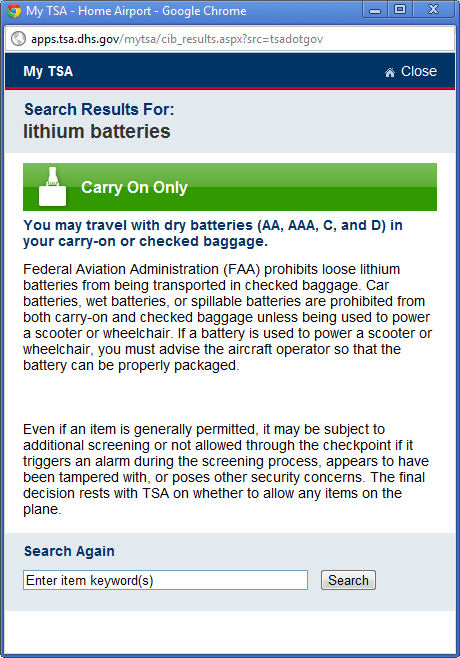6 Traveler Tips for Safely Transporting Spare Lithium Batteries
22 December 2011Travelers these days are carrying a far greater variety and number of electronic devices – laptops, iPads, MP3 players, smart phones, toys and more. And with each of those devices comes a battery, and in many cases, spare batteries as well.
What you may not be aware of is this fact: the Federal Aviation Administration (FAA) prohibits spare lithium batteries (i.e., those that are not installed in a deactivated and locked electronic device) from being transported in checked bags.
Following a United Parcel Service plane crash in Dubai, the FAA acknowledged the potential danger of transporting lithium batteries due to the risk of cargo fires. As of January 1, 2008, the Department of Transportation (DOT) no longer allows loose lithium batteries in checked luggage.
The theory is that with spare batteries in the passenger compartment (instead of in the cargo hold), flight crews can better monitor the conditions and access fire extinguishers if a fire does occur.
What is the TSA’s Stand on Lithium Batteries?
When we typed ‘lithium batteries’ into the TSA’s ‘Can I bring’ tool, we got this information:
For those traveling with battery-powered wheelchairs or scooters, note the detail regarding safe packaging.
Safe Spare Lithium Battery Travel Tips
For personal use, there is currently no restriction on the number of spare batteries allowed in a traveler’s carry-on luggage. This means cell phone batteries, hearing aid button cells, and common AA/AAA batteries available in retail stores as well as standard laptop batteries.
The following are recommended safe travel tips for spare batteries:
- Buy your batteries from reputable sources and look for the mark of independent testing such as the Underwriters Laboratories (UL) or International Electrotechnical Commission (IEC). Counterfeit batteries are more likely to cause a fire in your equipment.
- If you are carrying spare batteries, keep them in your carry-on luggage.
- Prevent potential short-circuiting by keeping the batteries in their original retail packaging or by placing tape across the contacts to isolate the terminals.
- Keep each battery away from other batteries and metal objects such as coins, keys, and jewelry.
- Pack your batteries carefully to avoid crushing, puncturing, or any high degree of pressure on the battery, which can result in an internal short-circuit and risk overheating and fire.
- If you pack a device containing batteries, secure the device against accidental activation by locking it, placing it in a protective case, etc.
Do Not Board with Accidentally Charged non Rechargeable Batteries
It’s also very important that you never charge a non-rechargeable battery. Rechargeable and non-rechargeable batteries are not interchangeable! Non-rechargeable batteries become potential fire hazards when placed in a battery charger. If you’ve accidentally charged a non-rechargeable battery, do not attempt to bring that battery on board an aircraft.
Damian Tysdal is the founder of CoverTrip, and is a licensed agent for travel insurance (MA 1883287). He believes travel insurance should be easier to understand, and started the first travel insurance blog in 2006.


